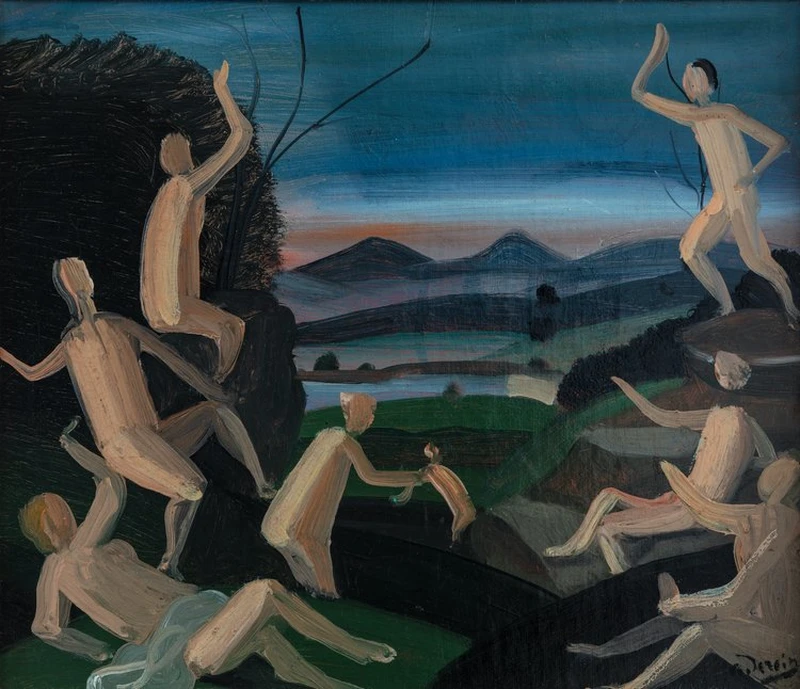André Derain and The Stage
12 Sep-26 Oct 2024


How apt, for a painter as in love with playing as André Derain, for his first formal collaboration with the theatre to have been for a production of La Boutique Fantasque, a ballet in which the toys in a toyshop come alive? Commissioned by Sergei Diaghilev for a production of his Ballets Russes at London’s l’Alhambra in 1919, the sets and costumes Derain designed for La Boutique Fantasque marked the beginning of the artist’s official work for the stage, an engagement he would pursue right up until his death in the early 1950s. In this time he became a true creator of ballets, writing librettos and selecting music; as Roland Petit noted in relation to a production of Que le diable l’emporte, ‘Derain did everything. He chose the music, wrote the ballet’s subject, and, ultimately, crafted the costumes and sets with his unique genius.’
This exhibition, however, starts fifteen years earlier, with La Poupée of 1904, and takes as its scope the much broader equation of André Derain’s relationship to the stage. For Derain, a painting was always a theatre, his figures choreographed like actors and his landscapes arranged as though by a director of mise-en-scène. The canvas was the platform on which he could perform, and in spite of the immense variety of his methods we can see this position of art as a matter of staging holding true for the full half century of making represented by the works in this exhibition.
This is the 70th year since the artist’s death, and in that time the art of Derain has, in my view, often been misinterpreted. On the one hand his pursuit of the traditional genres, landscape, portrait, still- life etc., has led to accusations of conservatism, when in fact his strategies for dealing with those genres are highly avant-garde. On the other, those same strategies have led to him being labelled an ‘artist’s artist’, which is a self-defeating and largely untrue term, for Derain was well-recognised in his lifetime as one of the major artists of the period. What has been lost to view, or at least not sufficiently appreciated, is his fantastic capacity for playfulness, the joy he takes in making a toy for himself out of the language of painting and the history of art. Ultimately these games extend to the experience of the viewer, who must suspend their disbelief when looking at these pictures in the same was as they do at the theatre, if they are to disentangle the breadth of reference and the depth of the artist’s painterly humour. It is for this reason that ‘the stage’ is a useful lens through which to re-examine the art of Derain.
All of the works here include human figures, but they are never quite human beings - their souls are not of interest to Derain. Instead they are are ‘types’, characters, performances of people, with no inner lives to speak of even when they appear to have been drawn from life. Instead, the artist uses these bodies as tropes, pieces of content, through which he can explore, with great erudition and wit, a set of stylistic and formal references taken from the history of art. These range from the classical to the so-called ‘primitive’, from the antique to the contemporary, including images and forms taken from folk traditions, Greek and Roman friezes, Etruscan antiquities, fleshy Baroque altarpieces, playing cards, the marginalia of Medieval manuscripts, Byzantine mosaics and many more. When he gives his figures clothes they are more like costumes, when they are nude they are posed as though for the artist and the viewer rather than for themselves. The line that connects them, that demonstrates that these images are the work of one artist rather than many, is Derain’s treatment of each subject as though he is once removed, as though he is not just producing an image of a thing but rather an object made up of a set of references to historical forms. It is an attitude that is not conservative at all - rather, it is the strategy of postmodernism half a century early, the game of an artist who has access to the whole history of images and the joie de vivre to be irreverent with them. It is a sensibility which makes Derain our contemporary, which connects him to a figure like Sigmar Polke, for one, and so many artists living today.
Sequentially towards the end of this exhibition we have the Baigneuses of the mid 1940s, a work which could almost be a design for a stage. The figures, arranged with such theatrical composure, are like matchstick-characters in a cartoon, their bodies reduced to a few loosely-painted lines, and the landscape recedes in such a way that it feels that if you could change your position only slightly you would see it was contrived of a series of staggered boards. The genre, bathers, or more broadly nudes in a landscape, is among the most solid and enduring in European art, and here calls to mind the work of Nicolas Poussin, the arch-classicist, who made his paintings by assembling miniature stage-sets and populating them with clay figurines. In Derain’s work that illusion is made to rest on a knife-edge, the fragile artifice of the most traditional painting laid bare and frankly celebrated. This is his brilliance: to take the art of the past and push it into the territory of the 20th century with his tongue in his cheek.
I am most grateful to Adrien Delestre, whose partnership and expertise in organising this presentation has been both essential and a joy, as well as to Virginia Stoppenbach, who has kindly loaned us some of these works from her extraordinary collection.
For more information please contact [email protected] or [email protected]